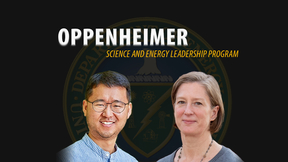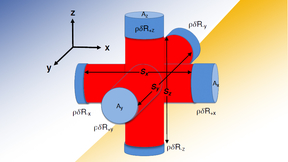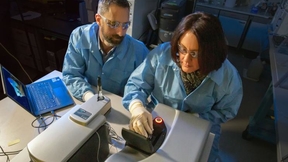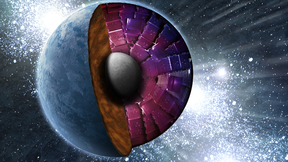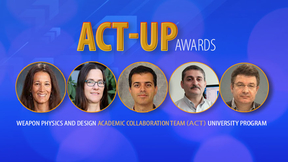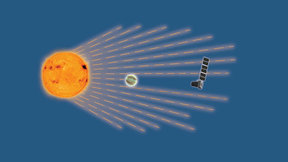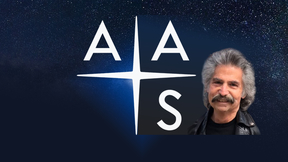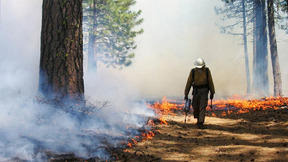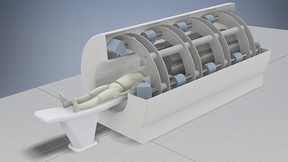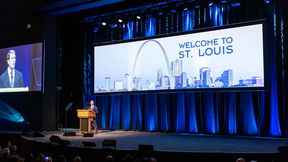Back
Science
Two LLNL scientists honored as 2022 Oppenheimer Science and Energy Leadership fellows
The Oppenheimer Science and Energy Leadership Program (OSELP) has selected Lawrence Livermore National Laboratory computer scientist Kathryn Mohror and materials scientist T. Yong Han as 2022 fellows. Established in 2017, OSELP is a distinguished fellowship program that brings together exceptional leaders to explore the complexities, challenges and opportunities facing the…
Lawrence Livermore National Laboratory's '2021 Year in Review'
While the impacts of the COVID-19 pandemic continued to be felt, 2021 marked an exceptional year for Lawrence Livermore National Laboratory (LLNL) in science, technology and operations. LLNL’s month-by-month highlights from 2021 are available online in the "2021 Year in Review" edition of Newsline. Listings are in three categories: Science and Technology, People and…
LLNL thin film engineer named fellow of SPIE
Lawrence Livermore National Laboratory’s (LLNL) Christopher Stolz has been elected as a fellow of SPIE, the international society for optics and photonics. Stolz, an associate program manager in charge of the National Ignition Facility (NIF) optics supply, has worked at LLNL in the laser directorate as a thin film engineer for more than 30 years; first in AVLIS and then…
Larry Durham selected as LLNL’s chief human capital officer and Human Resources associate director
Larry Durham has been named Lawrence Livermore National Laboratory’s (LLNL’s) new chief human capital officer and associate director for Human Resources (HR AD). The selection was announced today by LLNL Director Kimberly Budil and Principal Associate Director for Operations & Business Cynthia Rivera and will be effective Jan. 24, 2022. As chief human capital officer,…
Research looks at ‘piston-model’ to understand impacts of asymmetry on ICF implosions
New research conducted at Lawrence Livermore National Laboratory (LLNL) explores the expansion of a classical mechanics model, which has been useful for understanding asymmetries in inertial confinement fusion (ICF) implosions, from a two-piston to a six-piston model to capture higher-mode asymmetries. The work is featured in the Physics of Plasmas. LLNL authors included…
Lab researchers and collaborators to develop new vaccine against three biothreat pathogens
Scientists from Lawrence Livermore National Laboratory (LLNL) and three other institutions are seeking to develop a multi-pathogen vaccine that will protect against three bacterial biothreat pathogens. Led by LLNL, the team includes disease experts from the University of New Mexico Health Sciences Center (UNMHSC), the University of Nevada, Reno School of Medicine (UNR Med)…
Ironing out the interiors of exoplanets
The discovery of more than 4,500 extra-solar planets has created a need for modelling their interior structure and dynamics. As it turns out, iron plays a key role. Lawrence Livermore National Laboratory (LLNL) scientists and collaborators have used lasers at the National Ignition Facility to experimentally determine the high-pressure melting curve and structural…
Lab’s ACT-UP awards focus on collaborative university research
With a focus on increasing joint research efforts between Lawrence Livermore National Laboratory and universities, the Lab’s Weapon Physics and Design (WPD) Academic Collaboration Team University Program (ACT-UP) has presented this year’s ACT-UP awards. Now in its third year, the ACT-UP awards were created to encourage and advance strategic partnerships among universities…
Pandora mission to study stars and exoplanets continues toward flight
The Pandora mission, co-led by a national laboratory and a NASA flight center, has passed a crucial step on its path to study stars and planets outside our solar system, or exoplanets. After a successful concept study report and system requirements review, NASA approved the mission to continue toward flight. Lawrence Livermore National Laboratory (LLNL) and NASA’s Goddard…
LLNL scientist honored as 2022 American Astronomical Society fellow
LLNL physicist Richard Klein has been selected as a 2022 fellow of the American Astronomical Society. Klein, who was selected “for broad and influential contributions to computational astrophysics, for scientific achievements on radiatively-driven stellar winds and star formation theory and for training a generation of students and postdoctoral scholars,” is one of 23…
Fire may increase long-term carbon storage
Wildfires and prescribed burns, which can promote soil organic matter stability, may be an important nature-based climate solution to increase long-term carbon storage. That is the conclusion of an international team of researchers, including a scientist from Lawrence Livermore National Laboratory (LLNL), who looked at the effect of wildfires and prescribed burns on the…
LLNL establishes AI Innovation Incubator to advance artificial intelligence for applied science
Lawrence Livermore National Laboratory (LLNL) has established the AI Innovation Incubator (AI3), a collaborative hub aimed at uniting experts in artificial intelligence (AI) from LLNL, industry and academia to advance AI for large-scale scientific and commercial applications. LLNL has entered into a new memoranda of understanding with Google, IBM and NVIDIA, with plans to…
Digital twins for cancer patients could be ‘paradigm shift’ for predictive oncology
A multi-institutional team, including a Lawrence Livermore National Laboratory (LLNL) contributor, has proposed a framework for digital twin models of cancer patients that researchers say would create a “paradigm shift” for predictive oncology. Published online in Nature Medicine on Nov. 25, the proposed framework for Cancer Patient Digital Twins (CPDTs) — virtual…
International delegation of military women, CGSR exchange knowledge on emerging security issues
An all-female group of senior military officers from 12 nations recently visited the Center for Global Security Research (CGSR) and Lawrence Livermore National Laboratory (LLNL) to share information and expertise regarding current perspectives, research and technology in areas affecting global security. The visit was part of the 2021 Halifax Peace with Women fellowship, a…
Microfabricated thin-film electrodes show therapeutic promise
Earlier this year, thin-film microgrid arrays developed at Lawrence Livermore National Laboratory (LLNL) and used in neurologist Jon Kleen’s patients at the University of California, San Francisco (UCSF) showed that hippocampal brain activity consisted of waves that traveled bi-directionally during behavioral tasks. These thin-film microgrid arrays are designed not just to…
Radiation to cancer patients in a ‘FLASH’
Researchers at Lawrence Livermore National Laboratory (LLNL) have shown for the first time the potential for linear induction accelerators (LIAs) to deliver effective, targeted doses of “FLASH” radiation to cancer patients. The new technique selectively kills cancer cells with minimal damage to healthy cells. The approach is outlined in a Scientific Reports paper. For…
Playing it safe: LLNL scientist creates energetic compounds with isotopic labels
Ana Racoveanu is able to do something most others throughout the nuclear security enterprise cannot do — something challenging and extremely valuable throughout the complex. Racoveanu, a staff scientist in Lawrence Livermore National Laboratory’s Materials Science Division, is able to synthesize energetic compounds with isotopic labels. The primary goal of this work is to…
Meet me in St. Louis (virtually or in person): First-ever hybrid Supercomputing conference sports strong Lab flavor
It was a Supercomputing conference like none other before it. For the first time ever, the 2021 International Conference for High Performance Computing, Networking, Storage and Analysis (SC21) went hybrid, with dozens of both in-person and virtual workshops, technical paper presentations, panels, tutorials and “birds of a feather” (BOF) sessions. Under the ongoing specter…
LLNL team wins SC21 Reproducibility Advancement Award
A suite developed by a Lawrence Livermore National Laboratory (LLNL) team to simplify evaluation of approximation techniques for scientific applications has won the first-ever Best Reproducibility Advancement Award at the 2021 International Conference for High Performance Computing, Networking, Storage and Analysis (SC21). Newly instituted by the conference, the award…
HPC for Energy Innovation issues new solicitation for clean energy projects
The U.S. Department of Energy's (DOE) High Performance Computing for Energy Innovation (HPC4EI) initiative, managed by Lawrence Livermore National Laboratory, is seeking proposals for projects that can leverage DOE supercomputing to advance clean energy technologies. The fall 2021 solicitation targets industry partners for collaborations with DOE national laboratories that…


